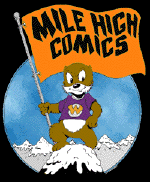Meeting with Jim Shooter in May of 1979
|
When Marvel's Marketing Vice President, Ed Shukin, took me down the hall to introduce me to Jim Shooter in May of 1979, my life changed forever. Jim had been at Marvel for just under two years at that point, but the company was already beginning to see dramatic improvement in Marvel's editorial output as a result of the comprehensive changes he had put into place. Not only did Shooter have most of the books back on a proper timing schedule, but the actual content of the stories was starting to be consistantly good. This may seem like a given today, but the mid-1970's were not the high point of creative output at Marvel. While there were certain runs of titles that prospered during that period, and a few are actually considered classics of the art form, even the most die-hard Marvel Zombie can usually be brought to admit that many of the 1970's Marvel comics are barely readable. This may explain, in part, why almost no Marvel titles begun during! the 1970's continued uninterupted through the present. The sole exception would be the revival of Uncanny X-Men, which was helped for two decades by Chris Claremont's engaging stories. The reason why Jim Shooter was able to put his mark so strongly on Marvel was because Stan had chosen to gradually withdraw to California during the 1970's, leaving a string of creators in charge of day-to-day operations. Stan certainly continued to contribute to Marvel's editorial oversight during this period, but his desire was clearly for someone else to take over the helm of the company. While Roy Thomas, Len Wein, Marv Wolfman, and Archie Goodwin all were brilliant in their own way, they were individually not able to provide the leadership that Marvel needed during those troubled times. With newsstand sales falling steadily, and a majority of titles shipping late for one reason or another, both Stan and Marvel President Jim Galton were ultimately willing to take a chance on putting dark horse candidate Jim Shooter in charge of all of Marvel's editorial output. By this one bold stroke, Marvel's third Golden Age (after 1939-1945 and 1961-1969) was begun. I could go on for many columns about the plus's and minus's of Jim Shooter's eight-year reign at the helm of Marvel editorial. It is no secret that Jim was very opinionated in his perceptions of what constituted quality writing and comics art, and that his autocratic management style could sometimes offend even his best friends. To this day, even the mention of Jim Shooter's name can cause some otherwise very calm and reasoned creators to spew an astounding level of bile and venom. In this instance, however, his interactions with his staff are pretty much irrelevant. When I first walked into his office on that momentous day in May of 1979, I found myself in the company of the best ally that the Direct Market retailers ever had at any of the comics publishers. What made Jim Shooter so important to the development of the Direct Market was that, unlike almost everyone else at Marvel in 1979, Jim already knew about Phil Seuling's Seagate Distributing. He not only knew what Phil was doing, he had taken the time, completely of his own accord, to track Phil's sales on each and every title that Marvel printed. He told me in that very first conversation, for example, that he had discovered that Phil was already selling as much as 6% of certain fan-favorite titles, such as Uncanny X-Men. The net result of his analysis of Phil's business was that he believed absolutely that the future of comics lay in retailing through comics specialty shops. From the moment we first met, Jim Shooter and I also became good friends. Jim had seen the letter I had sent to Bob Maillo (Ed Shukin's assistant) and was more than willing to help me understand which of my ideas for improving relations with the Direct Market retailers had potential for success with Marvel's management, and which were doomed from the start. Were it not for this guidance from Jim Shooter, I honestly believe that my earnest discussions with Ed Shukin and Jim Galton would have come to naught. It was only when Jim came out strongly in favor of some of the reforms I had proposed during management meetings, long after I had left the Marvel offices, that the actual decisions were made to alter the marketing strategies of the company. In many regards, Jim Shooter had a far more important impact on the development of our present system of Direct Market comics shops than anyone has ever realized.My letter to Bob Maillo was the catalyst that initiated th! e 1979 change in direction of Marvel's marketing to comics shops, but it was Jim Shooter who ultimately did all the heavy lifting. To be continued...
Mile High Comics, Inc.
|
| Previous | Next |

